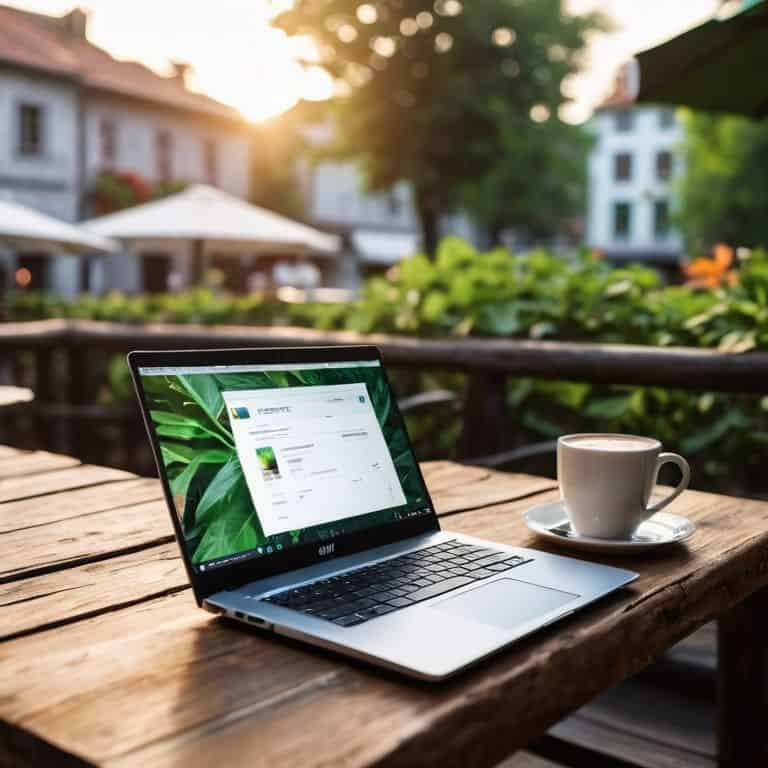I still remember the day I decided to ditch my 9-to-5 and become a digital nomad – it was like a weight had been lifted off my shoulders. But, as I soon discovered, the reality of life on the road is far from the glamorous Instagram posts that make it look so effortless. The truth is, being a digital nomad requires a lot of behind-the-scenes work, and having the right digital nomad essentials can make all the difference between a successful adventure and a frustrating struggle. I’ve learned that it’s not just about having the latest gadgets or trendy gear, but about finding the tools and strategies that actually work for you.
As someone who’s been in the game for over a decade, I’m excited to share my honest, no-BS advice on what it really takes to thrive as a digital nomad. In this article, I’ll be covering the practical essentials you need to know, from the best gear to stay connected and productive, to the strategies for finding reliable Wi-Fi and navigating unfamiliar cities. My goal is to give you the lowdown on digital nomad essentials, without any of the fluff or hype, so you can focus on what really matters – experiencing the world and building a life you love.
Table of Contents
Guide Overview: What You'll Need

Total Time: 2 hours 30 minutes
Estimated Cost: $100 – $300
Difficulty Level: Intermediate
Tools Required
- Laptop (with a reliable battery)
- Portable Power Bank (capable of charging a laptop)
- Travel Adapter (universal, for foreign outlets)
- Smartphone (with a good camera and international capabilities)
- Noise-Cancelling Headphones (for focused work in noisy environments)
Supplies & Materials
- Comfortable Backpack (for carrying essentials while traveling)
- Travel Wallet (with RFID blocking material)
- Portable Wi-Fi Hotspot (for reliable internet access)
- Cloud Storage Subscription (for backing up important files)
- Virtual Private Network (VPN) Subscription (for secure internet browsing)
Step-by-Step Instructions
- 1. First, let’s talk about the basics of gear you’ll need to get started as a digital nomad. I’m not talking about fancy laptops or the latest smartphones, but the essentials that will keep you connected and productive on the road. Invest in a good portable power bank, a reliable backpack, and a sturdy laptop stand to help you work comfortably in coffee shops or co-working spaces.
- 2. Next, you’ll need to consider your digital security. This is not just about having a good antivirus program, but also about being mindful of public Wi-Fi networks and using a VPN to protect your data. I always recommend investing in a portable Wi-Fi hotspot, especially when traveling to countries with questionable internet security. It’s a small price to pay for the peace of mind that comes with knowing your data is safe.
- 3. Now, let’s dive into the world of productivity tools. As a digital nomad, you’ll need to stay organized and focused, even when working in distracting environments. I swear by my trusty planner and a set of colorful pens to keep track of my schedule and deadlines. You should also consider investing in a project management tool like Trello or Asana to help you stay on top of your work.
- 4. When it comes to accommodation, many digital nomads opt for short-term rentals or hostels. However, it’s essential to do your research and read reviews from other travelers before booking a place. I always look for accommodations with a fully equipped kitchen, as cooking my own meals saves me money and helps me maintain a healthy diet on the road.
- 5. To make the most of your digital nomad experience, you’ll need to be flexible and adaptable. This means being open to new experiences, trying new foods, and being willing to step out of your comfort zone. Don’t be afraid to try geocaching or other local activities that will help you meet new people and immerse yourself in the culture.
- 6. As a digital nomad, you’ll need to stay connected with your community back home. This can be challenging, especially when you’re working across different time zones. I recommend scheduling regular video calls with friends and family, and using social media to stay up-to-date with what’s happening in your industry.
- 7. Finally, don’t underestimate the importance of self-care when living a nomadic lifestyle. It’s easy to get burned out when you’re constantly on the move, so make sure to prioritize activities that bring you joy and help you relax. For me, this means cooking a hearty one-pot meal in my hostel kitchen or taking a yoga class at a local studio. Whatever it is, make time for it, and your body and mind will thank you.
Digital Nomad Essentials

As I’ve learned from my years of traveling, having the right gear can make all the difference in staying productive on the road. One of my top recommendations is investing in a portable wifi hotspot device, which has been a lifesaver in areas with spotty internet connection. I’ve also found that the best laptops for remote work are those that are lightweight, durable, and have a long battery life.
When it comes to planning your travels, don’t forget to research travel insurance for digital nomads, which can provide peace of mind in case of unexpected medical or travel-related issues. I’ve also discovered that using productivity apps for freelancers can help streamline your work and stay organized, even in the most chaotic of environments.
For those looking to minimize their luggage, I swear by minimalist packing tips, which involve packing only the essentials and learning to do without the rest. And when you need a break from working in cafes or hostels, consider checking out co-working spaces around the world, which offer a community of like-minded individuals and a productive work environment.
Best Laptops and Productivity Apps
When it comes to laptops, I swear by my trusty MacBook Air – it’s lightweight, powerful, and has never let me down in a pinch. But if you’re on a budget, consider a reliable Chromebook or a refurbished model. As for productivity apps, I’m a fan of Todoist for task management and Evernote for note-taking. These tools have been lifesavers on more than one occasion, especially when navigating language barriers or juggling multiple projects on the go.
I also recommend investing in a good password manager and a cloud storage service like Dropbox or Google Drive. These will save you from the nightmare of lost documents or hacked accounts, and give you peace of mind as you work from coffee shops or co-working spaces.
Portable Wifi Hotspots for Remote Work
When it comes to staying connected on the go, a portable wifi hotspot is a lifesaver. I’ve tried a few different options, but my go-to is still the Skyroam hotspot – it’s reliable, affordable, and covers most of the countries I visit. Another solid choice is the Keepgo hotspot, which offers pay-as-you-go data plans and decent speeds. Whatever you choose, make sure it’s compact, battery-life is decent, and the data plans won’t break the bank.
I’ve learned to always pack my portable wifi hotspot in my daypack, so I can work from anywhere – a coffee shop, a park, or even a geocaching spot. It’s freed me up to work from some amazing locations, and I can stay productive even when I’m in the middle of nowhere.
No-BS Essentials: 5 Tips to Keep You Sane on the Road
- Pack a portable power bank to keep your devices charged during long layovers or coffee shop work sessions
- Invest in a good VPN to secure your internet connection and protect your data from prying eyes
- Choose a laptop with a solid-state drive and at least 16GB of RAM to ensure seamless performance
- Download productivity apps like Trello, Evernote, or RescueTime to stay organized and focused
- Consider purchasing travel insurance that covers gear loss or theft, because accidents can happen to even the most seasoned nomads
Key Takeaways for Digital Nomad Essentials
Ditch the tourist traps and invest in solid gear, like portable wifi hotspots and reliable laptops, to stay connected and productive on the road
Mastering one-pot hostel kitchen cooking and geocaching in new cities can be a game-changer for digital nomads looking to immerse themselves in local culture
Remember, the three-day rule is key: spend your first 72 hours in a new city getting lost, trying street food, and avoiding tourist sites to truly experience the local vibe
The Real Deal on Digital Nomadism
The most essential thing you can pack as a digital nomad isn’t a gadget or a gizmo – it’s a willingness to be uncomfortable, to take risks, and to trust that the unknown is where the real magic happens.
Clara Bishop
Embracing the Digital Nomad Lifestyle

As I wrap up this guide to digital nomad essentials, I want to emphasize that being prepared is key to thriving in this lifestyle. From portable wifi hotspots to the best laptops and productivity apps, having the right gear can make all the difference. I’ve shared my own experiences and lessons learned from years of living and working on the road, and I hope that my advice has been helpful in preparing you for your own adventures. Whether you’re a seasoned traveler or just starting out, immersion is the name of the game – don’t be afraid to get a little lost and try new things.
So as you set out on your own digital nomad journey, remember that it’s not just about the destinations you visit or the gear you carry – it’s about the freedom to create the life you want, wherever you are in the world. Don’t be held back by fear or uncertainty – with the right mindset and essential tools, you can overcome any obstacle and achieve your goals. Happy travels, and I’ll see you on the road!
Frequently Asked Questions
What are the most reliable portable power banks for keeping my devices charged on the go?
Honestly, I swear by Anker and Mophie power banks – they’ve saved my bacon on countless long-haul bus rides and cafe sessions. Look for something with at least 20,000mAh capacity and multiple USB ports to charge your devices simultaneously.
How do I ensure my digital nomad gear is secure and protected from theft or loss while traveling?
Honestly, gear security is a top concern for me too. I swear by a good backpack with secure pockets and a reliable tracking device, like a Tile or TrackR, to keep tabs on my essentials. Also, make sure to label and insure your gear – it’s a hassle, but trust me, it’s worth it in case of an emergency.
What are the top considerations for choosing a portable wifi hotspot that can handle heavy remote work demands?
When choosing a portable wifi hotspot for heavy remote work, I look for devices with robust 4G LTE coverage, low latency, and high data limits. Consider the number of devices you need to connect and opt for a hotspot with multiple SIM card slots for flexibility. Don’t skimp on battery life, either – you’ll want something that can last a full workday.
